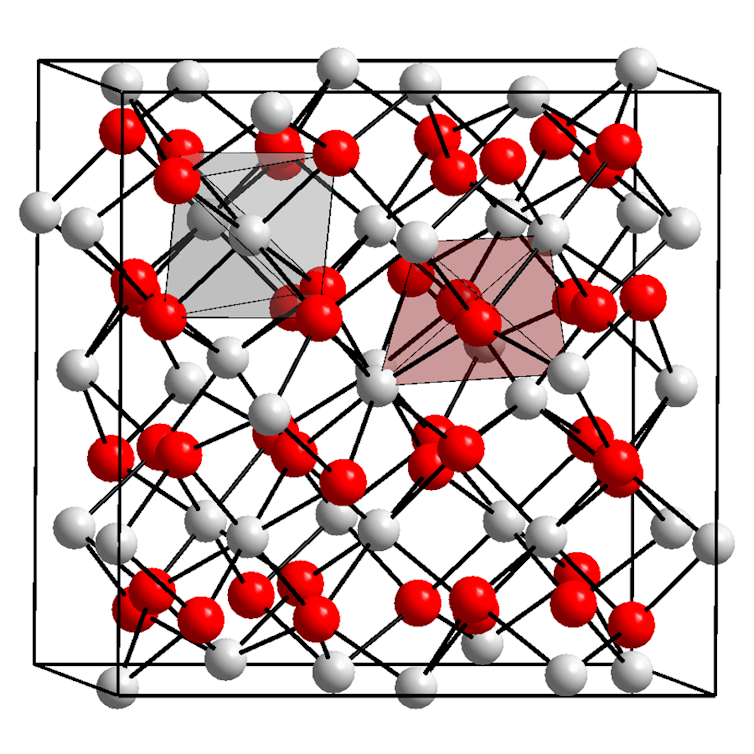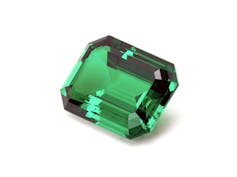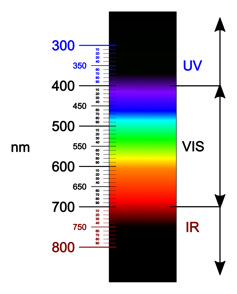The colours of rubies and emeralds are so putting that they outline shades of crimson and inexperienced – ruby crimson and emerald inexperienced. However have you ever ever puzzled how they get these colours?
I’m an inorganic chemist. Researchers in my subject work to grasp the chemistry of all the weather that make up the periodic desk. Many inorganic chemists concentrate on the transition metals – the weather in the midst of the periodic desk. The transition metals embody a lot of the metals you might be conversant in, like iron (Fe) and gold (Au).
One function of compounds made with transition metals is their intense coloration. There are numerous examples in nature, together with gem stones and paint pigments. Even the colour of blood comes from the protein hemoglobin, which accommodates iron.
Investigating the colours of compounds containing transition metals leads you into some actually superb science – that’s a part of what drew me to check this subject.
Rubies and emeralds are nice examples of how a small quantity of a transition metallic – on this case, chromium – can create an attractive coloration in what would in any other case be a reasonably boring-looking mineral.
Minerals and crystals
Rubies seem crimson as a result of they soak up blue and inexperienced gentle.
benedek/E+ through Getty Photographs
Each rubies and emeralds are minerals, which is a sort of rock with a constant chemical composition and a extremely ordered construction on the atomic degree.
When this extremely ordered construction extends in all three dimensions, the mineral turns into a crystal.
With a principle developed by physicists within the Twenties known as crystal subject principle, scientists can clarify why rubies and emeralds have the colours they do. Crystal subject principle makes predictions about how a transition metallic ion’s construction is affected by the opposite atoms surrounding it.
Rubies are primarily made up of the mineral corundum, which consists of the weather aluminum and oxygen in a daily, repeating array. Every aluminum ion is surrounded by six oxygen ions.

A crystal of corundum seems to be like this on the atomic degree, with the aluminum ions proven as crimson balls and the oxygen ions proven as white balls. Every aluminum ion is surrounded by six oxygen ions, and every oxygen by 4 aluminums.
Eigenes Werk/Wikimedia Commons, CC BY-SA
Emeralds are primarily made up of the mineral beryl, which is constituted of the weather beryllium, aluminum, silicon and oxygen. Beryl’s crystal construction is extra difficult than corundum’s due to the extra parts within the formulation, however every aluminum ion is once more surrounded by six oxygen ions.

Emeralds seem inexperienced as a result of they soak up crimson and blue gentle.
SunChan/E+ through Getty Photographs
Pure corundum and beryl are colorless. The good colours of rubies and emeralds come from the presence of very small quantities of chromium. The chromium replaces about 1% of the aluminum within the corundum or beryl crystal when a ruby or emerald kinds underground at a excessive temperature and strain.
However how can one component – chromium – create the crimson coloration of a ruby and inexperienced coloration of an emerald?
Colour science
Rubies and emeralds have the colours they do as a result of, like many substances, they soak up some colours of sunshine. Most seen gentle, like daylight, consists of all the colours of the rainbow: crimson, orange, yellow, inexperienced, blue, indigo and violet. These colours make up the seen gentle spectrum, which is straightforward to recollect as ROY G BIV.

Objects soak up some seen gentle wavelengths and replicate others, which is why we see them as having a coloration.
Fulvio314/Wikimedia Commons, CC BY-SA
One of many major the explanation why objects have a coloration is as a result of they soak up a number of of those seen colours of sunshine. If a substance absorbs, for example, crimson gentle, it signifies that the crimson gentle will get trapped within the substance and the opposite colours replicate again to your eyes. The colour you see is the sum of the remaining gentle, which will likely be within the green-to-blue vary. If a substance absorbs blue, it can look crimson or orange to you.
Not like the colorless aluminum ion, the chromium ion absorbs blue and inexperienced gentle when surrounded by the oxygen ions. The crimson gentle is mirrored again, in order that’s what you see in rubies.
In an emerald, though the chromium is surrounded by six oxygen ions, there’s a weaker interplay between the chromium and the encompassing oxygen ions. That’s as a result of presence of silicon and beryllium within the beryl crystal. They trigger the emerald to soak up blue and crimson gentle, leaving the inexperienced so that you can see.
The flexibility to tune the properties of transition metals like chromium by way of altering what’s surrounding it’s a core technique in my subject of inorganic chemistry. Doing so may also help scientists perceive the fundamental science of metal-containing compounds and the design of chemical compounds for particular functions.
You possibly can take delight within the superb colours of the gem stones, however by way of chemistry, it’s also possible to see how nature creates these colours utilizing an infinite number of advanced constructions made with the weather within the periodic desk.